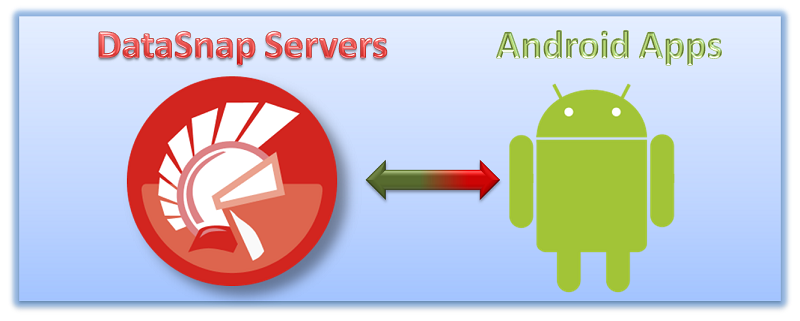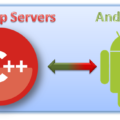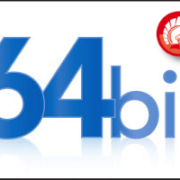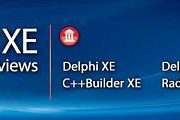Android apps connected to Delphi DataSnap Server
On the following video I’m showing how you can create DataSnap REST Server in Delphi, expose server methods and call them from an Android application. The video shows all the steps to create the server and the Android application.
This is a short recap of the video.
In order to have other platforms connecting and interacting with your DataSnap Server you need to enable the REST Interface, and for mobile platforms you can use the DataSnap Connectors that generate proxy classes for Android, BlackBerry, Windows Phone and iOS. In the video I’m showing how to create the Server, let’s take a look at the Server Method implementation.
The first server method called InsertCountry, connect on my InterBase database and add a new record to the Country table, see the implementation below:
function TServerMethods1.InsertCountry(Country, Currency: String;
out Error: String): Boolean;
var
Comm: TDBXCommand;
begin
Result := False;
DBConn.Open;
Comm := DBConn.DBXConnection.CreateCommand;
Comm.CommandType := TDBXCommandTypes.DbxSQL;
Comm.Text :=
Format('Insert Into Country (COUNTRY, CURRENCY) Values ( ''%s'', ''%s'')',
[Country, Currency]);
if not Comm.IsPrepared then
Comm.Prepare;
try
Comm.ExecuteUpdate;
Comm.Free;
Result := True;
except on E: Exception do
Error := E.Message;
end;
end;
The second server method is called GetCountries, and returns all the records I have in the COUNTRY table on my InterBase database. This method returns a DBXReader and DataSnap will convert this automatically to JSON at the moment the Android app calls this method, but since we will use the new DataSnap Connector to generate the proxy class, we won’t need to handle the JSON object and I will explain that after.
The following code represents the GetCountries implementation.
function TServerMethods1.GetCountries: TDBXReader;
var
Comm: TDBXCommand;
begin
DBConn.Open;
Comm := DBConn.DBXConnection.CreateCommand;
Comm.CommandType := TDBXCommandTypes.DbxSQL;
Comm.Text := 'Select * from Country';
if not Comm.IsPrepared then
Comm.Prepare;
Result := Comm.ExecuteQuery;
end;
The next step is to create the proxy class for Android using the DataSnap connectors, which is a new feature in Delphi XE2. The generation can be done through command line or via HTTP request on your DataSnap server, and in the video I’m showing how to do that.
The proxy generator generates only the DSProxy.java, all the other files part of the DataSnap Connectors are the representation of DataSnap Framework in Java, for example you won’t need to parse the DBXReader as JSON object in Java, just because we have the DBXReader class in Java and it parses the JSON object for you.
The first step to create a REST connection with your DataSnap Server, which will give me a instance of DSRESTConnection. If your DataSnap Server requires authentication you can use the methods SetUserName and SetPassword to define the credentials.
private DSRESTConnection getConnection() {
DSRESTConnection conn = new DSRESTConnection();
conn.setHost("192.168.254.128");
conn.setPort(8080);
return conn;
}
Now, let’s take a look and see how to execute the server methods, starting with the InsertCountry method as you can see in the following code.
After instantiation of the DSRESTConnection, we pass the REST connection object to the TServerMethods1’s instance, which is the client representation of TServerMethods1 on the server, and from there just call InsertCountry.
Since InsertCountry returns Boolean and also the Error message parameter is passed as reference, InsertCountry methods will return a InsertCountryReturns, which is a static class with two parameters: error that represent the error message and returnValue which represent the value return by InsertCountry.
protected void Insert() {
DSRESTConnection conn = getConnection();
TServerMethods1 sm = new TServerMethods1(conn);
try {
InsertCountryReturns ret;
ret = sm.InsertCountry(editCountry.getText().toString(), editCurrency.getText().toString(), "");
if ( ! ret.returnValue ) {
System.out.println(ret.error);
}
} catch (DBXException e) {
e.printStackTrace();
}
// Hide keyboard
InputMethodManager imm = (InputMethodManager)getSystemService(Context.INPUT_METHOD_SERVICE);
imm.hideSoftInputFromWindow(editCountry.getWindowToken(),0);
}
The next method is GetCountries. We start as before by getting the DSRESTConnection instance. The GetCountries method returns a DBXReader and the way we work with the DBXReader class in Java is very similar the way we work in Delphi, use the Next method to interact through the result, and getValue/GetAsXXXXX to get the column value. See the following code:
protected void Refresh() {
DSRESTConnection conn = getConnection();
TServerMethods1 sm = new TServerMethods1(conn);
TDBXReader reader;
try {
reader = sm.GetCountries();
ArrayList COUNTRIES = new ArrayList();
while (reader.next()) {
COUNTRIES.add(reader.getValue("COUNTRY").GetAsString());
}
// Add the COUNTRIES array in to the list view
list.setAdapter(new ArrayAdapter(this, android.R.layout.simple_list_item_1, COUNTRIES));
} catch (DBXException e) {
e.printStackTrace();
}
}
This is just a short tutorial explaining how to use DataSnap Connector with Android, take some time and watch the video where I’m going through more details.
The source code is available for download here and download the video from here.








COUNTRIES.add(reader.getValue(“COUNTRY”).GetAsString()) looks a little overcomplicated when compared with typical JDBC result set processing in Java. Maybe a future version of DataSnap will allow more intuitive code like reader.getString(“field”) … ?
Michael,
The proxy in Java is matching the same structure we use in Delphi for dbExpress Framework.
Hi,
I’m doing some tests on Android to call a DataSnap server method that
returns a simple class.
Delphi Side:
TPrueba = class
private
FUnString : string;
public
published
property UnString : string read FUnString write FUnString;
end;
Java Side:
private class TPrueba {
public String UnString;
}
With the following Datasnap server method:
function RetornaEstructura(Value : string) : TPrueba;
When I generate the java.android proxy the method returns a TJSONObject.
1. Is the Java class definition ok to match the Delphi one and be able parse
it?
2. I have tried using the Google.GSon library to parse the TJSONObject with
no success. it is possible?
I get a empty Prueba when I call Prueba = g.fromJson(JSonObj.toString(),
Prueba.getClass()); or am I doing it wrong?
3. Is there another way to parse the TJSONObject and load into the
TPrueba Java class?
Thanks in advance,
Omar Zelaya
Hi, I need to develop an Android application that connects to an Delphi application using a web service . Some ideas ?? Help me please !!!
@Statik0,
You just need to import the WSDL on the Android side, google and you will find a lot of videos.
Where can I download this sample source code on Delphi and Java.
Thank you.
What should be the setHost and setPort of the getConnection() funcion when you deploy the WebService as isapi dll?
I get “Host may not be null” all the time.
Thank you
setHost should be IP or hostname of the machine running the DataSnap Server and port should be 8080, unless you changed the default
With a dll in an IIS server with the 8080? I thought the port was 80 as HTTP in IIS.
With IP and port 8080 doesn’t work. I compile the dll, put it in a server with other ISAPIs and no way i can’t get a connection in Java.
with http://192.168.2.5/TestRest.dll i get the default DataSnap REST Project webpage.
I don’t know if i’m doing something wrong.
Thank you very much… that’s a record time answer!
In IIS will be port 80 by default and try to call some server method, just http://192.168.2.5/TestRest.dll won’t do anything
Finnally got it:
conn.setHost(“192.168.2.5”);
conn.setPort(80);
conn.setUrlPath(“/TestRest.dll”);
Thanks
Hi,
I followed your example to connect to datasnap and create an android app but it is not working on the android side. for some reason I does not post back to the table or refresh the data. It does work if i use a web page but not from eclipse. any Ideas?
@Remmie I’m not understanding what is the problem, can you please clarify.
Andreano, I think is the eclipse system on my PC It just will not “talk” with the REST Server for some reason. calling the same address from a web browser works. but not from the Android emulator. I am trying to do the same in RADPHP and having problems with the DBXReader. I do not know how to access it. ??
got it thanks.
in the first example InsertCountry ther is Comm.Free,
in the second example GetCountries no. Why ?
Thanks
Giovanni, because on the second one I return the cursor through the TDBXReader, as the server finish to send the cursor to the client side it will be automatically destroyed by the server.
Andreano, primeiramente quero parabeniza-los pelos post, muito util para a comunidade, gostaria de saber como posso fazer para compartilhar a function getConnection() com outras class, sem a precisar refazer a function em cada class, fazendo apenas a chamada, já tentei assim:
ClassConexao Conexao = new ClassConexao();
DSRestConnection conn = Conexao.getConnection();
Mas não funciona, se puder ajudar fico muito grato
Sergio Kawahara
Hello Lanusse im getting a error “incorrect type in dbxvalue” if the table has a field of data type integer
when i call in my code
COUNTRIES.add(reader.getValue(“ID”).GetAsInt16());
if i call using
COUNTRIES.add(reader.getValue(“ID”).GetAsString()); i have the same error
How fill my adapter with a field with data type int in my table
Thanks
Andreano, gostaria de parabenizá-lo pelo excelente tutorial.
Estou começando a desenvolver em Android agora e já consegui implementar o codigo sem problemas na API 10 (Android 2.3.3), infelizmente não consego em nenhume API lançada após a 10. Já quebrei a cabeça bastante mas não encontro solução. Gostaria de lhe pedir uma ajuda para esse caso. Fico muito grato.
Obrigado
você tem essa aula em Português?
Hi! Nice job on this tutorial!
I understood all the guidelines but how can i aproach the access to datasnap server without that proxy libraries? I mean, using tipical url queryng using json as output format?
Adriano buen día.
estoy incursionando en desarrollos para android con delphi xe6. una aplicación sencilla hecha con datasnap y dbexpress. Desde el móvil tengo conección perfecta con mi base de datos sql server 2008, cuando quiero modificar un registro o actualizar me da el siguiente error:Exception in safecall method
cuando aplico el metodo ClientDataSet – ApplyUpdates. Que puede ser? Gracias